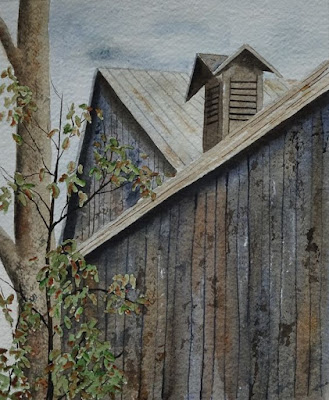Some people and art associations assess paintings based on rigid theoretical rules of paintings. Some of those rules included
- focal point: this represents a center of activity, attraction, or focus in a painting
- values: applying different values to show depths
- texture: use of different techniques to create texture
Of particular interest today is the rule related to the need for a focal point. In some cases a focal point, the area of emphasis, could be a small portion of the painting. In other case, the point of interest might be a focal area where a larger section of the painting engages the eye.
Some people and art associations, including some local ones, do not consider paintings without a focal point to be well designed.
This mindset does not recognize that there are other equally valuable approaches to painting where a single area of emphasis is NOT needed. In many cases, the painting itself is the emphasis. The artist composes his or her painting with some sort of pattern throughout, causing the entire painting to become the center of attention.
One kind of pattern is the repetition of a subject as this painting by John Salminen.
A different kind of repetition—that of a single image set in a tic-tac-toe grid—is found in Andy Warhol’s Marilyn, another work where no focal point exists.
Even though one’s eye might enter through any one of the images, its repetition keeps the eye moving throughout the painting. It is impossible to say that the eye enters at any single point.
Having a focal point can be a valuable tool (just like any other compositional tool available) but as any research will show, they’re not absolutely necessary to the success of a painting.
It's unfortunate that some of people and art associations do not acknowledge that each painting does NOT needs to have a focal point. It’s entirely up to the artist to decide.
This narrow minded interpretation discourage experimentation and creativity. Isn't art suppose to support originality?
This week's painting is unlike my recent ones since I felt frustrated following comments from a local art association that does not appreciate paintings without a clear center of interest.
This is a painting of a cupola on an old barn not too far from here.
I have some ideas for old tools that I will start painting in the coming weeks. Painting what I enjoy will not be swayed by some other needs to meet a number of theoretical principles.
Have a great week
Danielle
This narrow minded interpretation discourage experimentation and creativity. Isn't art suppose to support originality?
This week's painting is unlike my recent ones since I felt frustrated following comments from a local art association that does not appreciate paintings without a clear center of interest.
This is a painting of a cupola on an old barn not too far from here.
I have some ideas for old tools that I will start painting in the coming weeks. Painting what I enjoy will not be swayed by some other needs to meet a number of theoretical principles.
Have a great week
Danielle



Dear Danielle: You are sounding so defensive about the comments your local association made about the lack of proper composition in your watercolours:( But the Warhol example you give is a silkscreen not a watercolour and what was important and significant about his work was how he shifted colours and created off-register effects in the print process, which print artists before him had not done. He broke the rule about printing within the lines. In fact this example is properly composed when you consider the positioning of the face within one specific frame (it is not centered), and that the entire work is based on the rule of thirds.
ReplyDeleteJust like a successful author doesn’t write word after word without a structure or direction to the story, a successful painting has a focal point and the artist works to build relationships in the work to reinforce that focal point. If you look at yours, the copula is the centre of attention because it is so poorly executed and out of proportion (another rule for a successful work). So is the tree. The colours too don’t do anything to help so of course the entire painting becomes the centre of attention – but it is the kind you don’t want as an artist!
It is obvious that you are only a beginner so hang in there Danielle. You just need to practice more to understand the rules and implement them successfully first, before you can break them. Remember, just because you put a frame around it, or someone buys it, does not make it good art! Good luck!